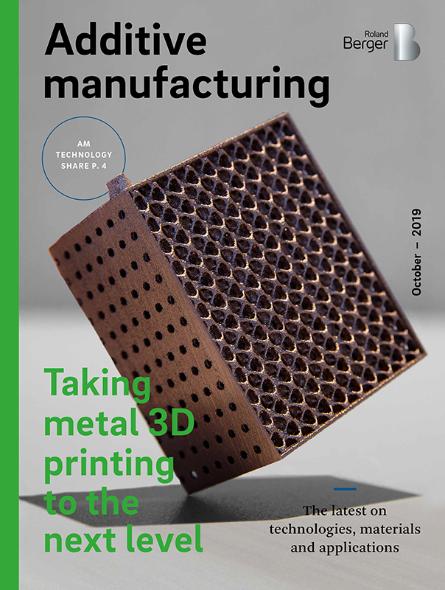Additive manufacturing – Taking metal 3D printing to the next level
![{[downloads[language].preview]}](https://www.rolandberger.com/publications/publication_image/RB_STU_Additive_Manufacturing_Cover_download_preview.jpg)
New commercial materials: Characteristics of new AM materials compared to AlSi10Mg


The latest developments in the additive manufacturing industry present exciting opportunities for serial production with the emergence of new technologies and materials. We follow up last year's RB Focus , «Advancements in metal 3D printing», with a deep dive into the latest insights from the machine market, material development, and application areas. While metal additive manufacturing has cleared the hurdle for series production in niche applications, novel technologies and materials will also soon become commercially available. Metal additive manufacturing by powder bed fusion is a well-established technology with production machines and systems available for both prototypes and small series production in aerospace, turbines, medical, and automotive. PBF and other metal additive manufacturing techniques are growing at a brisk pace compared with traditional technologies and will continue to do so next year.

Metal material prices have recently been declining and this trend is expected to continue, though at a lower rate. Most common materials, such as AlSi10Mg, Inconel 718, or 316L, can be purchased well below EUR 100/kg. Alloys containing more expensive metals, like titanium or scandium, however, will be found at a price range of EUR 100-200/kg. Nevertheless, as PBF metal materials currently make up only about 5-20 percent of all parts costs, the further price decline will only have a minor impact on the overall price of AM parts. Since the metal AM market is rather young, most commonly used materials have their origins in other applications and were found to be suitable for AM printing, rather than being designed expressly for the application.
Recent developments include approaches for using new metal powders and entirely new material types designed especially for AM. Scalmalloy, a scandium aluminum-magnesium alloy, was developed for AM applications in aerospace.
Still-new metal AM technologies (like material jetting or binder jetting) are evolving, enlarging the addressable market for AM.
New materials and process improvements are enabling new AM applications. For instance, static gas turbine components made of nickel-base alloys are being printed increasingly in series production. AM components boost the efficiency of gas turbines by enabling higher combustion temperatures and the reduction of maintenance times. This creates not only a positive business case within the lifecycle of AM components, but also speeds up delivery times, makes customizations easier, and reduces dependencies on the conventional supply chain.
Recently, new applications/configurators for copper and copper alloys have been developed, due to the outstanding electrical and heat transport properties of this metal. These include induction coils and high-performance heat exchangers. The challenge in printing this material is its different absorption spectra.
The slow-moving industrialization of manufacturing technologies influences all major AM market participants. Currently, many AM printing service providers, especially small ones, have problems reaching their machine capacity utilization. The reasons are twofold: On the one hand, strong sales of AM machines with standard dimensions in recent years have led to a large installed machine base in this segment. As a result, competitive pressure has lowered the prices of commodity components with standard dimensions. On the other hand, additive manufacturing is only used for series production in specialized niche applications in industries such as turbomachinery, which often require process qualification.
![{[downloads[language].preview]}](https://www.rolandberger.com/publications/publication_image/RB_STU_Additive_Manufacturing_Cover_download_preview.jpg)
New commercial materials: Characteristics of new AM materials compared to AlSi10Mg